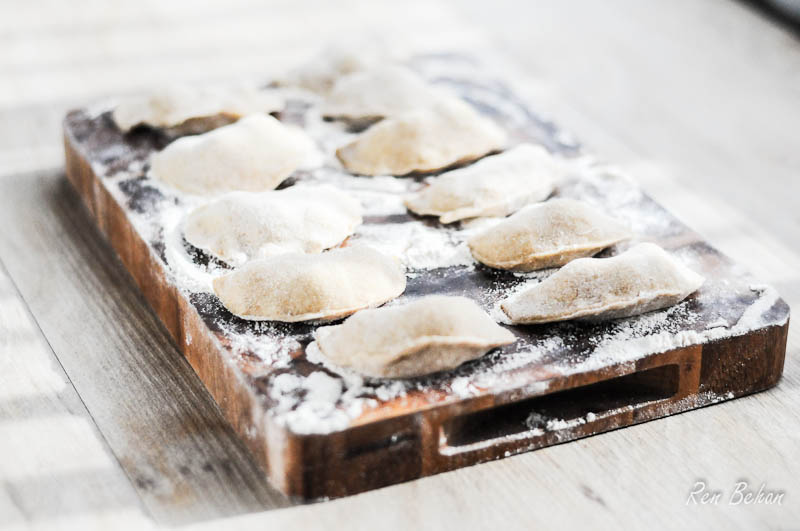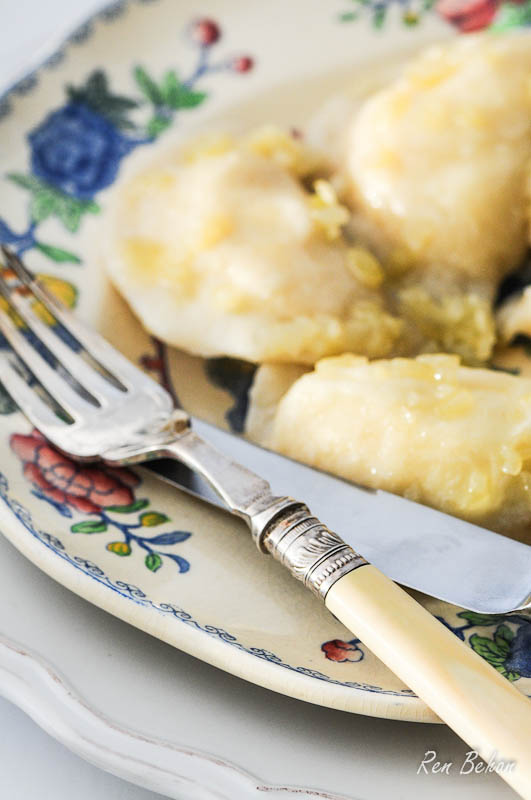How To Make Pierogi

Being Polish and having an insatiable love of pierogi go hand in hand. For me they conjure up images of a big family table, my Mama cooking endless batches, dishing up little pockets of dough, similar to ravioli, filled with potato and cheese or foraged mushrooms, coated in warm butter and caramelized onions and sometimes, słonina, a kind of oozingly melty type of pork fat. You basically get a massive hit of comfort; savoury, soft, and incredibly moreish. Done right – homemade pierogi are one of the best thing to come out of Poland and they are the one thing any Pole will crave away from home.
And then there are sweet pierogi; filled with plums, cherries or blueberries, which are my favourite and the easiest, I find, to make. You can sprinkle them with sugar, flavoured with cinnamon or vanilla and they can be pan-fried in a little butter.
You might have heard ‘pierogi’ described as ‘pierogies,’ though the term ‘Pierogi‘ is already plural. A single dumpling would be a ‘pierog,’ but since a plateful is usually served, they are collectively called Pierogi. They tend to be made in quite large batches, since they do take a little work, but my goodness, are they worth it…
The origins of pierogi are hard to trace – they are almost certainly Slavic and there are many variations of them within Polish, Ukranian, Russian, Lithuanian and Romanian cuisines. In Russia, they are known as pelmeni, in Lithuania, vareniki.
There are also comparisons to be drawn with Italian ravioli, as mentioned, given that pierogi are made with a simple dough of flour and water – and are filled with a variety of fillings, sweet or savoury. They are also almost certainly related in some way to Asian dumplings – possibly Chinese, Mongolian or even Persian. Sometimes, you might find a dough recipe with melted butter added, or even sour cream. My Mama adds an egg yolk, for a little richness.
Ruskie Pierogi (originating in the Kresy region of Poland where my father was born) are made with potato and farmer’s cheese and are probably the most popular filling you’ll find. Pierogi with wild or forest mushrooms and sauerkraut are most often served on Wigilia or Christmas Eve. You can also get all kinds of softly braised meat fillings.
You can find the step-by-step instructions for how to make pierogi, below.
How To Make Pierogi
To make pierogi, you make the dough, which is a process very similiar to making fresh pasta.
- You will need around 500g plain flour, a little lukewarm water, and you can add a beaten egg or an egg yolk for a slightly richer dough. For 500g flour, you’ll probably need around a cup of water water – but see how the dough feels and comes together. Add it a couple of tablespoonfuls at a time. Use a knife to bring the dough together, then mix by hand.
- Once you can bring the dough together, shape it into a ball and kneed it for just a couple of minutes. We always leave our dough to rest a little, in a bowl, with a little oil, covered with a damp tea cloth.
- After around thirty minutes, you can start to roll the dough out (in batches) on a floured surface. While you are working with the dough, leave the rest covered with a cloth so that it doesn’t dry out.
- Using an inverted glass, or a scone cutter, around 8cm in diameter, cut out circles of dough.
- Take one circle at a time in your hand, and fill with a filling of your choice, such fresh blueberries or strawberries, or a traditional savoury filling, such as mashed potato and cheese.
- Place a heaped tablespoon of filling onto one half of the circle then fold the other half over to make a semi-circle shape.
- Gently press together the edges together to enclose the filling, so that it doesn’t spill out during cooking.
- Line up the pierogi, and place a damp cloth over the top as you make the rest.
- Once made by hand, boiled them, in batches, in a large pan of boling water for just a few minutes and rise to the top of the pan when cooked – around 5 minutes.
- Drain and serve immediately – for savoury pierogi, top with onions fried in butter and sour cream, for sweet pierogi, sprinkle with sugar.
- Pierogi can also be re-heated by being pan-fried in a little butter, which gives them a slightly crispier outside and a totally different texture and flavour.
Very soon I’ll be showing you a video on how to make pierogi! Stay tuned!
Find the recipe for Sweet Blueberry Pierogi here.





